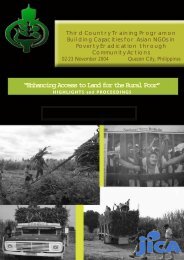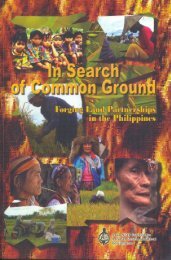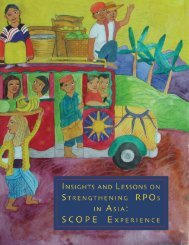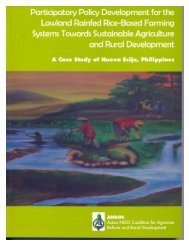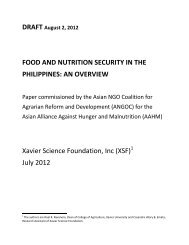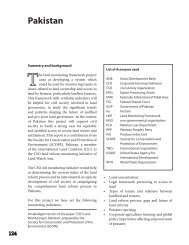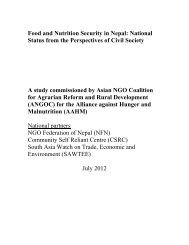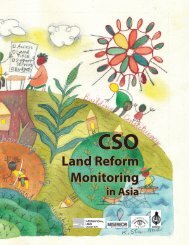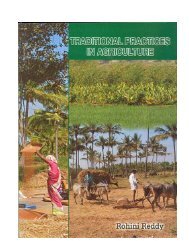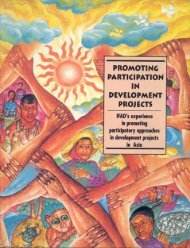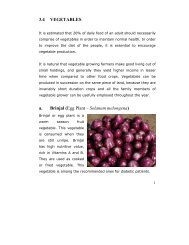Securing the Right to Land FULL - ANGOC
Securing the Right to Land FULL - ANGOC
Securing the Right to Land FULL - ANGOC
Create successful ePaper yourself
Turn your PDF publications into a flip-book with our unique Google optimized e-Paper software.
SECURING THE RIGHT TO LAND132<br />
PHILIPPINES<br />
QUICK FACTS<br />
Context of Access <strong>to</strong> <strong>Land</strong><br />
and Tenurial Security in <strong>the</strong><br />
Philippines 1<br />
Rural Poverty and <strong>Land</strong>lessness<br />
The country’s rich resources are <strong>the</strong> source of subsistence and<br />
livelihood for majority of <strong>the</strong> Filipinos. The forest ecosystem directly<br />
supports approximately 30% of <strong>the</strong> population, including<br />
indigenous peoples (MTPDP, 2004–2010). Sixty percent of some<br />
80 million Filipinos make <strong>the</strong>ir livelihood in some form of forestry<br />
or agriculture (Gould, 2002). According <strong>to</strong> <strong>the</strong> 2002 Labor<br />
Force Survey of <strong>the</strong> National Statistics Office, <strong>the</strong> agriculture<br />
sec<strong>to</strong>r employs one third of <strong>the</strong> country’s <strong>to</strong>tal employed per-<br />
➤ An archipelago of more than 7,100 islands<br />
➤ Composed of 79 provinces and 4 districts in <strong>the</strong> National Capital Region<br />
(NCR) grouped in<strong>to</strong> 16 regions and subdivided in<strong>to</strong> 1,623 municipalities,<br />
41,926 barangays and almost 15.3 million households.<br />
➤ Around 50% of 88.7 million Filipinos (2007 Census) lives in rural<br />
barangays.<br />
<strong>Land</strong><br />
➤ Total land area=30 million hectares; 45% upland/forests, 47% alienable<br />
and disposable lands (A&D) which are open for titling;<br />
➤ Around 10 million hectares of agricultural land with 4.8 million hectares<br />
of agricultural farms;<br />
➤ Forest cover decreased by 70% or 5.4 million hectares from 21 million<br />
hectares in 1900 (Philippine Environment Moni<strong>to</strong>r, 2004)<br />
Waters<br />
➤ 2.2 million km 2 or 220 million hectares of marine waters with a coastline<br />
of 17,640 kilometers;<br />
➤ Philippines ranked 11 th among <strong>to</strong>p fish producing countries in <strong>the</strong> world<br />
with production of 2.63 million <strong>to</strong>ns of fish, crustaceans, mollusks and<br />
aquatic plants. (FAO, 2003)<br />
➤ Municipal waters consist of <strong>the</strong> 15-kilometer coastal waters from <strong>the</strong><br />
shoreline; commercial fishing is not allowed unless approved by local<br />
governments<br />
Economy and Employment<br />
➤ Agriculture contributes an average 20% <strong>to</strong> <strong>the</strong> country’s Gross Domestic<br />
Product (GDP)<br />
➤ 37% of jobs coming from agriculture and fisheries<br />
sons. On <strong>the</strong> o<strong>the</strong>r hand, fisheries provide employment <strong>to</strong> 1.37<br />
million Filipinos (BFAR, 2002).<br />
Over 31 million poor Filipinos are found in rural areas (World Bank,<br />
2004). Within agriculture, farm workers in sugarcane, small farmers<br />
in coconut, rice and corn, fishermen, and forester households<br />
were found <strong>to</strong> be among <strong>the</strong> poorest of <strong>the</strong> poor, accounting for<br />
about 70% of all subsistence households in 2000 (NSCB, 2000).<br />
The Philippine agrarian structure is made up of small peasant<br />
farms and large plantations. In 1986, before <strong>the</strong> Comprehensive<br />
Agrarian Reform Program(CARP), government estimates indicated<br />
that around 20% of Filipino families controlled 80% of <strong>the</strong> lands.



